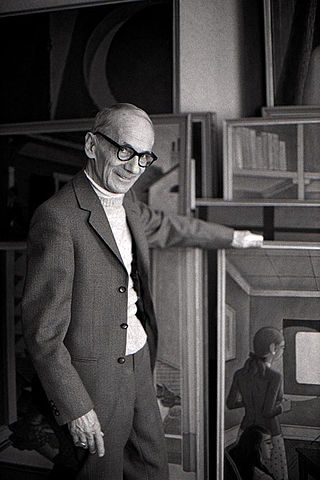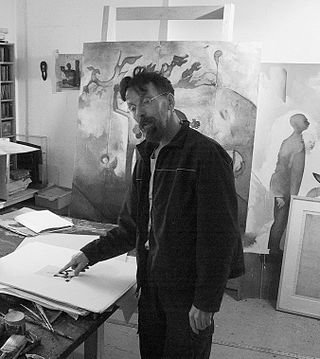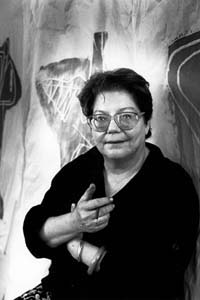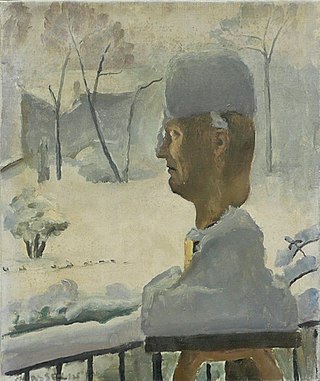
Lausanne is the capital and largest city of the Swiss French-speaking canton of Vaud. It is a hilly city situated on the shores of Lac Léman, about halfway between the Jura Mountains and the Alps, and facing the French town of Évian-les-Bains across the lake. Lausanne is located 62 kilometres northeast of Geneva, the nearest major city.

Jacint Rigau-Ros i Serra, known in French as Hyacinthe Rigaud, was a Catalan-French baroque painter most famous for his portraits of Louis XIV and other members of the French nobility.

Félicien Victor Joseph Rops was a Belgian artist associated with Symbolism, Decadence, and the Parisian fin de siècle. He was a painter, illustrator, caricaturist and a prolific and innovative print maker, particularly in intaglio. Although not well known to the general public, Rops was greatly respected by his peers and actively pursued and celebrated as an illustrator by the publishers, authors, and poets of his time. He provided frontispieces and illustrations for works by Jules Barbey d'Aurevilly, Charles Baudelaire, Charles De Coster, Théophile Gautier, Joris-Karl Huysmans, Stéphane Mallarmé, Joséphin Péladan, Paul Verlaine, Voltaire, and many others. Best known today for his prints and drawings illustrating erotic and occult literature of the period, he also produced oil paintings including landscapes, seascapes, and occasional genre paintings. Rops is recognized as a pioneer of Belgian comics.

Árpád Szenes was a Hungarian-Jewish abstract painter who worked in France.

Erling Mandelmann was a Danish photographer. He began his career as a freelance photojournalist in the mid-1960s.

Jacques-Henri Sablet was a Swiss-French painter, part of a family of artists of Swiss origin. He was also known as Franz der Römer, Giacomo Sablez, Giacomo Sablé, Jacob Henry Sablet, Sablet le Jeune, Sablet le Romain or le peintre du Soleil.
Yolande Ardissone is a French painter. Born in Bueil (Normandy), she studied at the Beaux-Arts and at the Académie de la Grande Chaumière in Paris.

Émile François Chambon was a Swiss painter and illustrator.

Fabienne Verdier is a French painter who works in France after years of studies in China. She was the first non-Chinese woman to be awarded a post-graduate diploma in fine arts by the Sichuan Fine Arts Institute in Chongqing, China.
Simon Joseph Simon-Auguste was a French artist, known for his intimate paintings, mainly portraits, nudes, and still lifes. His production is characterized by a calm, intimate feel and the effective use of glaze.
Berthe Constance Ursule Art was a Belgian still life painter.

Louis Rivier was a Swiss painter, writer, and stained glass artist.
Armande Oswald is a Swiss artist who has practised drawing, painting, engraving and scenography in the Neuchâtel area for a considerable period.

Jeanne Forain was a French painter and sculptor. She was the wife of the painter and caricaturist Jean-Louis Forain.

Louis-Pierre Bougie was a Canadian painter and printmaker specialized in engraving and etching. He developed his knowledge of intaglio techniques at Atelier Lacourière-Frélaut in Paris, where he worked for fifteen years, and through travel and study in France, Portugal, Poland, Ireland, Finland, and New York. His work is regularly shown in Canadian, American, and European galleries, and is represented in major public and private collections, notably in Québec and New York. Bougie was considered Québec's foremost engraver for the depth and consistency of his work. He died from pneumonia.

Ariane Laroux is a Franco-Swiss painter, draughtsman and printmaker. She is known for her black and white drawings, using void and empty spaces in her artworks. She has drawn portraits of renowned activists, while interviewing them, paying attention to having exactly the same number of women and men portraits in her books. She has exhibited several examples in the British Museum.

Aigle railway station is a railway station in the municipality of Aigle, in the Swiss canton of Vaud. It is an intermediate stop on the standard gauge Simplon line of Swiss Federal Railways and the terminus of three 1,000 mm gauge lines operated by Transports Publics du Chablais: the Aigle–Leysin, Aigle–Ollon–Monthey–Champéry, and Aigle–Sépey–Diablerets lines.

Francine Simonin was a Swiss-Canadian painter, engraver, and designer. She was considered to be an expressionist.

The Maison Moos, later called the Galerie Moos, was an art gallery and auction house founded in 1906 in Geneva by the art dealer Max Moos. The gallery closed in 1976.

Maurice Paul Jean Asselin was a French painter, watercolourist, printmaker, lithographer, engraver and illustrator, associated with the School of Paris. He is best known for still lifes and nudes. Other recurring themes in his work are motherhood, and the landscapes and seascapes of Brittany. He also worked as a book illustrator, particularly in the 1920s. His personal style was characterised by subdued colours, sensitive brushwork and a strong sense of composition and design.























